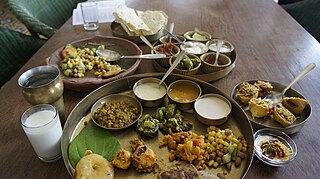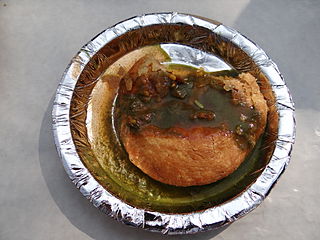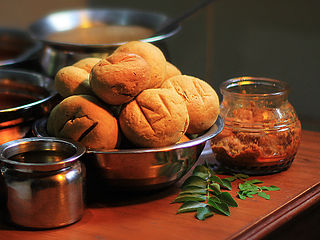Indian cuisine consists of a variety of regional and traditional cuisines native to the Indian subcontinent. Given the diversity in soil, climate, culture, ethnic groups, and occupations, these cuisines vary substantially and use locally available spices, herbs, vegetables, and fruits.

Rajasthani cuisine is the cuisine of the Rajasthan state in North West India. It was influenced by various factors like the warlike lifestyles of its inhabitants, the availability of ingredients in an arid region and by Hindu temple traditions of sampradayas like Pushtimarg and Ramanandi. Food that could last for several days and could be eaten without heating was preferred. Scarcity of water and fresh green vegetables have all had their effect on the cooking. Signature Rajasthani dishes include Dal Baati Churma, Panchratna Dal, Papad ro Saag, Ker Sangri, Gatte ro Saag. It is also known for its snacks like Bikaneri bhujia, Mirchi bada and Kanda kachauri. Other famous dishes include Dal Baati, malaidar special lassi (lassi) and Lashun ki chutney, Mawa lassi from Jodhpur, Alwar ka mawa, Malpauas from Pushkar and rasgulla from Bikaner, "paniya"and "gheriya" from Mewar. Originating for the Marwar region of the state is the concept Marwari Bhojnalaya, or vegetarian restaurants, today found in many parts of India, which offer vegetarian food of the Marwari people. The history also has its effect on the diet as the Rajputs preferred majorly a non-vegetarian diet while the Brahmins, Jains, Bishnois and others preferred a vegetarian diet. So, the state has a myriad of both types of delicacies.

South Asian cuisine, includes the traditional cuisines from the modern-day South Asian republics of Bangladesh, India, Maldives, Nepal, Pakistan and Sri Lanka, also sometimes including the kingdom of Bhutan and the emirate of Afghanistan. Also sometimes known as Desi cuisine, it has been influenced by and also has influenced other Asian cuisines beyond the Indian subcontinent.

Gujarati cuisine is the cuisine of the Indian state of Gujarat. The typical Gujarati thali consists of rotli, dal or curry, rice, and shaak. The thali will also include preparations made from pulses or whole beans such as moong, black eyed beans etc., a snack item (farsaan) like dhokla, pathra, samosa, fafda, etc. and a sweet (mishthaan) like mohanthal, jalebi, sevaiya etc.

Indian breads are a wide variety of flatbreads and crêpes which are an integral part of Indian cuisine. Their variation reflects the diversity of Indian culture and food habits.

Kachori is a sweet and spicy deep-fried snack, originating in India, and common in places with Indian diaspora and other South Asian diaspora. Alternative names for the snack include kachauri, kochuri, kachodi and katchuri.

Kadhi or karhi is a yogurt-based dish originating from Rajasthan, India. It's made by simmering yogurt with besan and spices until it forms a thick, tangy gravy. Sometimes, it's also mixed with pakoras. It is often eaten with cooked rice or roti. Varieties of kadhi include those from Rajasthan, Maharashtra, Gujarat, Punjab, and Sindh, all of which are located in present-day India and Pakistan.
Dal Bati Churma is the most popular dish in Rajasthani cuisine. It is made of three components of bati, dal, and churma. Dal is lentils, bati is a baked wheat ball, and churma is powdered sweetened cereal. Churma is a popular delicacy usually served with baatis and dal. It is coarsely ground wheat crushed and cooked with ghee and sugar. Traditionally it is made by mashing up wheat flour baatis or left over rotis in ghee and jaggery.

Kanda Kachori or Pyaaz Kachori is a Rajasthani snack and a variant of Kachori. It is a crispy, flaky, deep-fried pastry filled with spiced onion stuffing. It is typically served hot with a sweet and spicy tamarind chutney. Originating in the city of Jodhpur, pyaaz kachori is now enjoyed throughout Rajasthan and North India.
Bhojpuri cuisine is a style of food preparation common among the Bhojpuri people of Bihar and eastern Uttar Pradesh in India, and also the Terai region of Nepal. Bhojpuri foods are mostly mild and tend to be less hot in terms of spices used. The cuisine consists of both vegetable and meat dishes.

Churma is a popular Rajasthani, Bihari, Uttar Pradesi, Haryanvi, and Awadhi delicacy from India. In Punjab, the dish is called churi. It is coarsely ground wheat, crushed and cooked with ghee and sugar.
Bharunda is a village that comes under Sumerpur Tehsil in Pali district, Rajasthan. The Bharunda is an ancient village well connected to all surrounding villages and towns in the same vicinity.

Baigan bharta, also spelled bainganbharta or baigan chokha is an Indian dish prepared by mashing or mincing grilled eggplant (baigan) with tomato, onion, herbs and spices, with variations being common from chef to chef. Traditionally, cooking the eggplants over charcoals, inside of a tandoor, barbecue grill or oven, or even directly applying flame to the outside of the fruit infuses the dish with a smoky flavour; the blackened skin is then easily peeled and the eggplant may be further prepared.
Bihari cuisine is eaten mainly in the eastern Indian state of Bihar, as well as in the places where people originating from the state of Bihar have settled: Jharkhand, Eastern Uttar Pradesh, Bangladesh, Nepal, Mauritius, South Africa, Fiji, some cities of Pakistan, Guyana, Trinidad and Tobago, Suriname, Jamaica, and the Caribbean. Bihari cuisine includes Angika cuisine, Bhojpuri cuisine, Maithil cuisine and Magahi cuisine.
Marwari Bhojnalaya is a popular name among Marwari-style purely vegetarian restaurants in many cities in India. They are all independently owned. The term "marwari" implies that it is intended for Marwari merchants, who are strictly vegetarian and prefer relatively simple and inexpensive food. They are however popular among all vegetarians. The term "bhojanalaya" practically always implies simple and inexpensive vegetarian cuisine. Restaurants named "Jain Bhojanalaya" or "Vaishanva Dhaba" are also vegetarian. Note that restaurants are often called "hotel" in India. Some of them used to offer traditional seating on wooden patiyas on the floor, but the custom is no longer popular and tables and chairs are now more common.

North Indian Culture describes the cultural heritage of modern-day North India — the States of Punjab, Uttarakhand, Jammu & Kashmir, Haryana, Himachal Pradesh, Rajasthan, Uttar Pradesh, Gujarat, West Bengal, Jharkhand, Bihar Madhya Pradesh and Maharashtra. North Indian culture reflects the diversity of traditions and customs of the vast region it encompasses. North Indian Culture is mainly in sanatana traditions and customs, with the assimilation of — and impact from — other cultures over long periods of history. North Indian culture reflects the diversity of traditions and customs of the vast region it encompasses.

Daal Baati is an Indian dish of daal (lentils) and baati. It is popular in Rajasthan, Madhya Pradesh, Maharashtra's Khandesh and Vidarbha region, Gujarat, and Uttar Pradesh.

Maithil cuisine, also known as Mithila cuisine, is a part of Indian and Nepalese cuisine. It is the traditional cooking style of Maithils residing in the Mithila region of the subcontinent.
Cuisines and food of the Indian state of Haryana is known to be simple. People of the state prefer their food to be made with fresh ingredients and through simple recipes. Roti is a staple food in Haryana which is made from a variety of grains and flours. Since Haryana is rich with agriculture and cattle, the use of dairy products is abundant in their food. Many households churn out fresh butter from milk and use it as opposed to the butter available in the markets. Lassi is a popular and staple drink in Haryana. The food in Haryana finds a lot of similarities with its neighboring states Punjab and Rajasthan.
Consumption of non-vegetarian food is generally avoided in the state and sometimes is even considered a taboo among the rural population.
Katt Bafla is a popular and traditional dish from the Bundi district of Hadoti region in Rajasthan, India. It is a famous dish across the north Indian states in India. Traditionally this dish is made on every occasion in Rajasthan. In this dish Bafla is a type of spherical wheat bread whereas the Katt is a type of Barfi made with a mixture of unsalted wheat bread coarse powder with ghee and jaggery powder. Traditionally this dish is served with Daal and Kadhi.


















